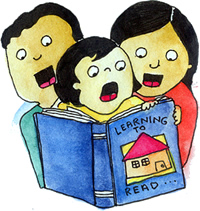A Tale of Two Children
Teachers know when a student doesn’t understand the lesson. When it comes to reading, we can tell their weakness and we know where they need help. The question is: Do we really know why? Mukhlis Abu Bakar helps us understand a different perspective of how children develop literacy skills by investigating the learning environment of the home.
 In 2005, Malays comprised 30% of students in the Learning Support Programme, a remedial intervention programme designed to help lower primary students having difficulty in school. While this has not gone unnoticed, attempts to explain the problem have been limited to reasons such as poor parental supervision, lack of academic interest among Malay youth, and a preoccupation with material comforts rather than education. This paints a stereotypical image of Malays as a people who are simply uninterested in learning.
In 2005, Malays comprised 30% of students in the Learning Support Programme, a remedial intervention programme designed to help lower primary students having difficulty in school. While this has not gone unnoticed, attempts to explain the problem have been limited to reasons such as poor parental supervision, lack of academic interest among Malay youth, and a preoccupation with material comforts rather than education. This paints a stereotypical image of Malays as a people who are simply uninterested in learning.
Muhklis Abu Bakar, an Assistant Professor with NIE’s Asian Languages and Cultures Department, did not believe that weak academic performance is an innate characteristic. He knew that there had to be other factors that influenced how these students performed in school. Hence his project, Malay Children’s Lived Experience of Literacy, which focuses on how Malay children learn literacy at home and in school.
Ikhsan and Sanah
In gathering data for his study, Mukhlis and his team visited the homes of 8 kindergarten children and their families. This section focuses on two of these children, namely, Ikhsan and Sanah. Below are excerpts of Mukhlis’ observations of two very different homes, and how their families assist in developing the children’s reading skills.
Observations
Ikhsan’s and Sanah’s homes are examples of the different ways Malay children are introduced to reading.
On one hand, you have Ikhsan, whose parents define literacy as the ability to decode text, read with proper intonation, and recognise punctuation marks. Given his ability to read on his own, Ikhsan will probably adjust well to primary school. However, decoding text is just one aspect of learning literacy. While he is able to read on his own, Ikhsan lacks the exposure to discuss the stories that he reads.
In contrast, Sanah is not fluent in English and cannot read on her own. Still, she attends to text like a reader in the way she comprehends, evaluates and questions the stories her mother reads to her. She detected the incoherency of her mother’s misreading of the phrase “we wonder, will we cry?” in the story, and tried to make sense of it based on her own experience. Compared to Ikhsan, it seems like Sanah is more capable of going beyond the text. This is an important skill in reading comprehension.
What does this mean for teachers?
The stories of Ikhsan and Sanah show how teachers must constantly challenge themselves to know more about the different capabilities that children bring to the classroom. As seen from Mukhlis’ study, there are a lot of things that we cannot see based on classroom worksheets and examinations alone.
For example, early primary teachers can easily make the mistake of assuming that Ikhsan’s skill in decoding text means he has a critical appreciation of what he reads as well. If teachers don’t help him develop the comprehension side of reading, this could affect his performance after Primary 3 when students are required to make meaning of texts as well as read them. In contrast, teachers must also take pains to notice the skills of children like Sanah, who can be mislabelled as “slow” because of her struggle with decoding text.
So where do Ikhsan and Sanah go from here? According to Mukhlis, all this depends on whether teachers are willing to really learn who their students are and how they work in the classroom. While Mukhlis’ study provides only a small glimpse of the literacies that children acquire at home, it highlights how much we actually don’t know about our students.
Mukhlis’ study challenges teachers to discover what resources their students have and don’t have before building an appropriate teaching strategy. According to him, they can do this during the first few months of the first year, through the many floor activities and oral/written tasks they carry out with the children and making a time to see parents after school. Assuming the wrong things about a child’s capabilities can eventually affect their entire learning experience.
Next steps
Mukhlis’ study is currently in its third year, and he continues to observe Ikhsan, Sanah and the other children as they enter primary school. He hopes to work with teachers who are interested in looking for evidence of children’s capacities, interests and strengths.
He also aims to help teachers interact with parents so they can better appreciate the rich family life that their students have. In fact, he has recently joined hands with another colleague to embark on another study to observe the literacy experience of Chinese children. Hopefully, this can then help teachers reassess their students’ potential in learning literacy.






